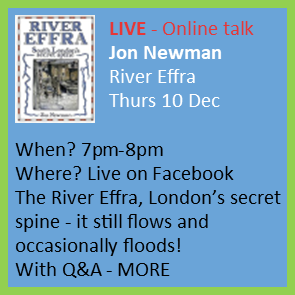
Jon Newman, The River Effra
Date: Thursday 10 December
Time: 7pm - approx 8pm
Where: This will be livestreamed on our Facebook page. There is no need to have a Facebook account to view.
Link to Facebook: www.facebook.com/TheNorwoodForum
Ask questions in advance here: info@norwoodforum.org
Ask questions during the talk: use the Comments box on Facebook (only available if you have a FB account)
Jon Newman’s River Effra, South London’s Secret Spine is lavishly-illustrated, deeply-researched and, above all, grippingly-readable. It’s a landmark work, the first detailed and comprehensive account of the Effra. This is a river, itself once a landmark, but for over a century and half now out of sight if not out of mind or urban myth.
Jon Newman told Vauxhallhistory.org:
‘What prompted me to write a book about the River Effra? In part it was a response to 25 years of overheard and often heated arguments in South London pubs about the river’s course: “Did it flow down Effra Road?” (In fact no). “Did it still feed into the Thames below Vauxhall Bridge?” (It never did). Then there was the trotting-out of the same hoary urban myths: “Did you know Queen Elizabeth sailed up the Effra in her barge to visit Walter Raleigh?” It was that and realising that most of the content already online that purported to tell the river’ story was really just an echo-chamber for the same old half-truths and quarter-fictions. No one had yet done a thorough job of researching and writing a history of the river, so I would have to.
‘The Effra flows the length of borough of Lambeth, rising in the hills of Upper Norwood and Crystal Palace and flowing north through West Norwood, Dulwich, Herne Hill, Brixton, Kennington and Vauxhall to enter the Thames just west of Vauxhall Bridge.
‘The residents of Vauxhall, South Lambeth Road and Kennington had been content to live along its bank at the end of the eighteenth century but by the middle of the nineteenth century they were confronted by a different beast: suburban development up-river in Brixton and Herne Hill had turned their erstwhile small sparkling stream into, effectively, a large open sewer. John Thomas, resident of South Lambeth Road and letter-writer to The Times, spoke for all his neighbours when in 1850 he complained of “Three feet of excrement always exposed to the lungs of the neighbouring population’. Were the cholera here now it would revel in this “Lethe of filth and abomination”, railed Mr Thomas.
‘So the Effra had to go, and in the mid-1860s the great Victorian engineer Joseph Bazalgette sank it into a sewer, and using the Effra’s flow to help drive the intercepting sewers carrying London’s sewage out to the Southern Outfall at Crossness1. The upper river still flows below ground – and occasionally floods – but north of the Southern High Level Sewer which crosses Brixton Road at Loughborough Road, the course of the Effra is effectively dry and reduced in function to an emergency storm drain.”
Jon is an experienced local authority archivist with substantial expertise in working as a consultant across all parts of the cultural sector where he has delivered successful projects for museums, galleries, libraries and archives, developing bespoke innovative and practical solutions to the funding, management, storage, interpretation and presentation of collections.
Follow Lambeth Archives on social media:
Facebook: www.facebook.com/LambethArchive
Twitter: twitter.com/LambethArchives
Instgram: www.instagram.com/lambetharchives/
